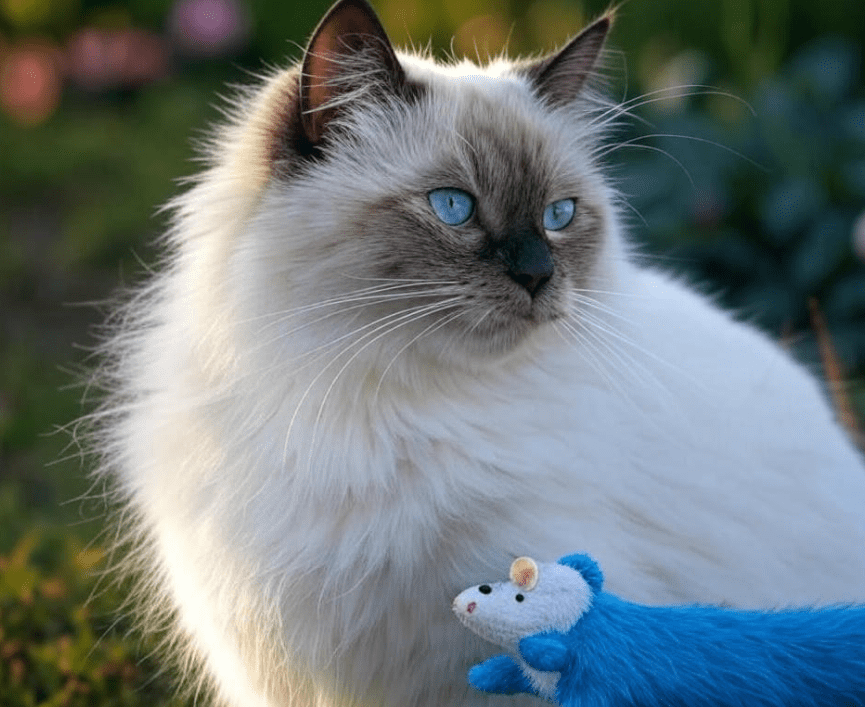
Ragdoll cats are so gentle with kids, making them one of the most beloved family pets for households with young children. Known for their calm demeanor, affectionate nature, and remarkable patience, Ragdolls have earned a reputation as the ideal feline companion for kids. Their unique temperament allows them to form strong bonds with children, fostering a safe and loving environment. In this comprehensive guide, we’ll explore why Ragdoll cats are so gentle with kids, delve into their personality traits, and provide practical tips for ensuring safe and enjoyable interactions between your child and your Ragdoll.
What Makes Ragdoll Cats So Gentle?
Ragdoll cats are renowned for their docile and placid personalities, which are key to their gentle interactions with children. Here’s a closer look at the characteristics that make Ragdolls such exceptional companions for kids:
1. Naturally Calm Temperament
Ragdolls are often described as having a “puppy-like” demeanor due to their relaxed and easygoing nature. Unlike more high-strung breeds, Ragdolls rarely display aggressive behavior. This calm temperament allows them to tolerate the unpredictable movements and loud noises that often come with young children.
Patience with Chaos: Ragdolls are less likely to become startled or defensive when kids are running around or playing loudly.
Low Aggression: Their non-confrontational nature means they’re more likely to walk away from a stressful situation than to scratch or hiss.
2. Affectionate and Social
Ragdolls thrive on human companionship and are known for seeking out affection. They often follow their owners around the house and enjoy being part of family activities. This sociability extends to children, who they view as playmates and sources of love.
Bonding with Kids: Ragdolls often form special bonds with children, enjoying gentle petting and cuddling.
Loyal Companions: Their loyalty makes them eager to participate in family life, from snuggling during storytime to “supervising” playtime.
3. Unique “Ragdoll” Behavior
The breed’s name comes from their tendency to go limp when picked up, much like a ragdoll. This behavior reflects their trusting and relaxed nature, which is especially beneficial when interacting with kids who may not yet understand how to handle pets gently.
Tolerant of Handling: Ragdolls are more forgiving of awkward petting or carrying, provided it’s not too rough.
Trusting Nature: Their willingness to relax in a child’s arms fosters a sense of trust and safety.
4. High Tolerance for Play
Ragdolls have a playful side but prefer gentle, low-energy games over roughhousing. This makes them well-suited for young children who may not yet have the coordination or strength for more intense play.
Interactive Play: Ragdolls enjoy toys like feather wands or soft balls, which kids can use to engage them safely.
Adaptable Energy Levels: They can keep up with a child’s energy without becoming overstimulated or aggressive.
Why Ragdolls Are a Great Match for Families

Beyond their gentle nature, Ragdolls possess several qualities that make them an excellent choice for families with children. Here’s why they stand out:
1. Safe and Non-Aggressive
Safety is a top priority when choosing a pet for a household with kids. Ragdolls are one of the safest breeds due to their minimal tendency to scratch or bite, even when provoked. This makes them ideal for families with toddlers or young children who are still learning how to interact with animals.
2. Easy to Train
Ragdolls are intelligent and responsive to training, which can help establish boundaries for safe play. Parents can teach their Ragdoll to avoid certain behaviors, such as jumping on furniture, or to come when called, making it easier to manage interactions with kids.
3. Low Maintenance Grooming
Ragdolls have semi-long coats that are surprisingly easy to maintain. Their fur is less prone to matting than other long-haired breeds, reducing the time parents need to spend on grooming. This allows more time for family bonding and play.
4. Emotional Benefits for Kids
Interacting with a Ragdoll can have significant emotional and developmental benefits for children. Caring for a pet teaches responsibility, empathy, and compassion, while the cat’s affectionate nature provides emotional support.
Stress Relief: Petting a Ragdoll can help children feel calm and reduce anxiety.
Building Confidence: Kids who learn to care for a pet often develop greater self-esteem and confidence.
Tips for Safe Play Between Ragdoll Cats and Kids
While Ragdoll cats are so gentle with kids, ensuring safe and positive interactions requires guidance from parents. Here are practical tips to foster a harmonious relationship between your child and your Ragdoll:
1. Teach Gentle Handling
Young children may not instinctively know how to handle a cat gently. Take time to demonstrate proper petting techniques and explain why rough handling can hurt the cat.
Demonstrate Soft Touches: Show your child how to stroke the cat’s back or head gently, avoiding sensitive areas like the tail or belly.
Supervise Interactions: Always supervise young children during play to prevent accidental harm to the cat.
2. Establish Boundaries
Setting clear rules for both the child and the cat helps create a safe environment. Teach your child to respect the cat’s space, especially when it’s eating, sleeping, or using the litter box.
Create a Safe Space: Provide a quiet area where the Ragdoll can retreat if it feels overwhelmed.
Teach “No” Zones: Explain that the cat’s food bowl, litter box, and bed are off-limits.
3. Use Age-Appropriate Toys
Encourage safe play by providing toys that both the child and the Ragdoll can enjoy together. Avoid toys with small parts that could be a choking hazard or strings that could cause injury.

Feather Wands: These are great for interactive play, allowing kids to engage the cat without direct contact.
Soft Balls or Stuffed Toys: Ragdolls love batting around lightweight toys, which kids can toss gently.
4. Teach Kids to Read Cat Body Language
Help your child understand the Ragdoll’s cues to know when it’s happy, stressed, or wants to be left alone. This prevents misunderstandings that could lead to scratches or stress for the cat.
Happy Signs: Purring, kneading, or a relaxed posture indicate the cat is content.
Warning Signs: A swishing tail, flattened ears, or hissing mean the cat needs space.
5. Encourage Responsibility
Involve your child in caring for the Ragdoll to build a sense of responsibility and strengthen their bond. Simple tasks like filling the water bowl or brushing the cat’s fur can be rewarding for kids.
Age-Appropriate Chores: For younger kids, tasks like giving treats or playing with the cat are ideal. Older kids can help with grooming or cleaning the litter box (with supervision).
Reward Positive Behavior: Praise your child for gentle and responsible interactions with the cat.
6. Monitor for Overstimulation
Even the most patient Ragdoll can become overstimulated during extended play. Watch for signs of fatigue or irritation and give the cat breaks as needed.
Short Play Sessions: Keep playtime sessions brief, especially with young children who may not notice when the cat is tired.
Provide Rest Time: Ensure the Ragdoll has access to a quiet space to nap and recharge.
Common Myths About Ragdoll Cats and Kids
Despite their stellar reputation, there are some misconceptions about Ragdolls and their interactions with children. Let’s debunk a few:
Myth 1: Ragdolls Are Always Okay with Rough Play
While Ragdolls are tolerant, they’re not invincible. Rough handling can stress them out or lead to injury. Always supervise play to ensure it remains gentle.
Myth 2: Ragdolls Don’t Need Training
Ragdolls are intelligent and benefit from training to reinforce good behavior. Teaching them to respond to commands or avoid certain areas can enhance safety.
Myth 3: Ragdolls Are Hypoallergenic
No cat is truly hypoallergenic, including Ragdolls. If your child has allergies, consult a doctor before bringing a Ragdoll into your home.
How to Introduce a Ragdoll to Your Kids
Introducing a Ragdoll to your children requires patience and preparation to ensure a smooth transition. Follow these steps for a successful introduction:
1. Prepare Your Home
Set up a safe space for the Ragdoll with food, water, a litter box, and a cozy bed. This gives the cat a place to retreat if it feels overwhelmed.
2. Explain Expectations to Kids
Before the cat arrives, talk to your children about how to behave around the new pet. Emphasize the importance of being gentle and patient.
3. Start with Short Interactions
Allow the cat to explore its new environment before introducing it to your kids. Once the cat seems comfortable, let your child interact with it for short periods under supervision.
4. Gradually Increase Bonding Time
As the Ragdoll becomes more comfortable, encourage longer play sessions and bonding activities, such as reading to the cat or playing with toys together.
Health Considerations for Ragdolls in Family Homes

Ragdolls are generally healthy, but like all breeds, they’re prone to certain health issues that can affect their interactions with kids. Here’s what to know:
1. Hypertrophic Cardiomyopathy (HCM)
HCM is a heart condition common in Ragdolls. Regular vet checkups can help detect it early, ensuring your cat remains active and playful with your kids.
2. Obesity
Ragdolls love food and can become overweight if overfed. Maintain a healthy diet to keep your cat energetic and ready for play.
3. Dental Health
Poor dental health can make a Ragdoll irritable. Brush their teeth regularly and provide dental treats to keep their mouth healthy.
Why Ragdolls Are the Ultimate Family Cat
Ragdoll cats are so gentle with kids because of their unique blend of patience, affection, and playfulness. Their calm demeanor, forgiving nature, and love for human companionship make them the perfect addition to families with children. By teaching kids how to interact safely and respectfully with their Ragdoll, parents can foster a lifelong bond that brings joy and emotional benefits to the entire family.
Whether you’re welcoming a Ragdoll into your home for the first time or looking to strengthen the bond between your cat and your kids, the tips and insights in this guide will help ensure safe, fun, and loving interactions. With proper care and guidance, your Ragdoll will become a cherished family member, creating memories that last a lifetime.
Additional Resources
Ragdoll Breed Clubs: Connect with organizations like the Ragdoll Fanciers Club International for breed-specific advice.
Veterinary Guidance: Consult your vet for personalized health and care tips for your Ragdoll.
Pet Safety Books for Kids: Books like The Way I Love You by Lisa Holloway can teach kids how to care for pets.
By following these tips and understanding the unique qualities of Ragdoll cats, you can create a safe and loving environment where your kids and your Ragdoll thrive together.




